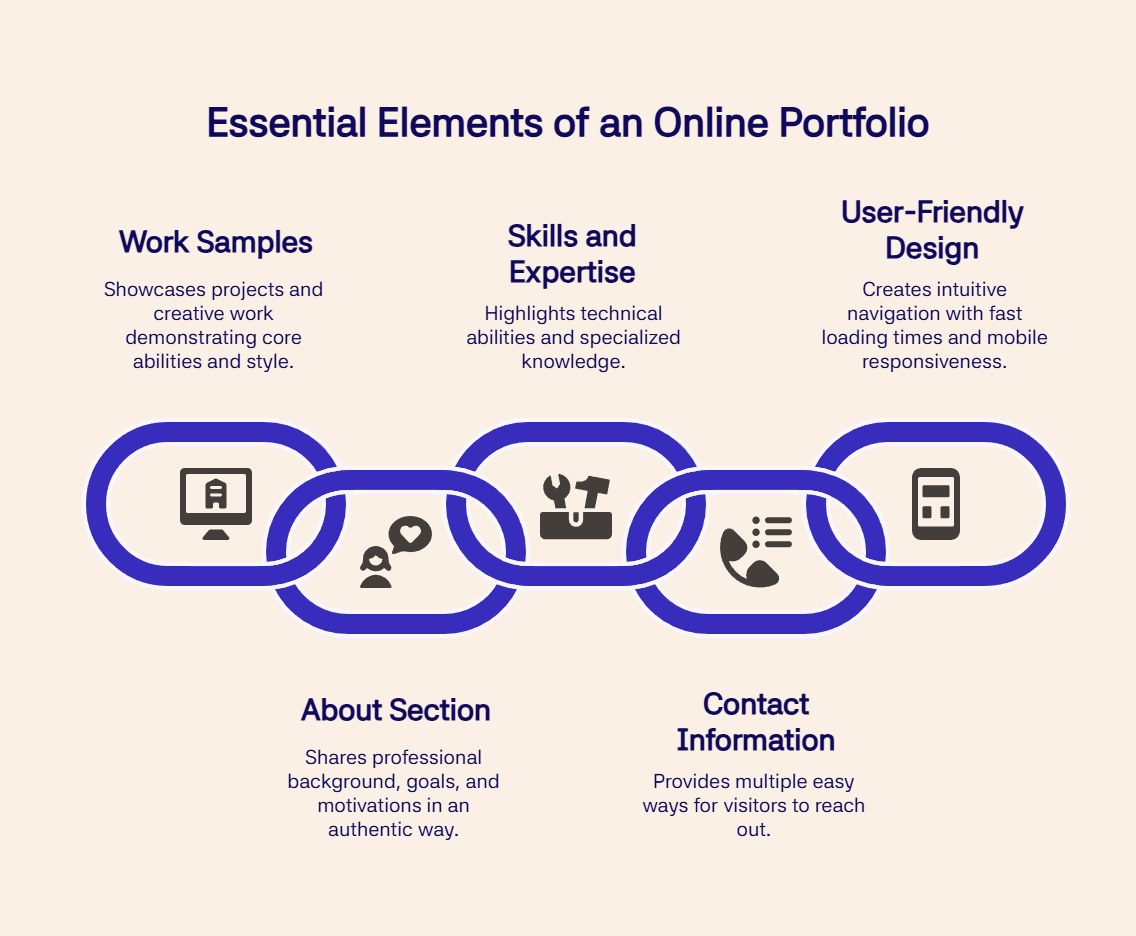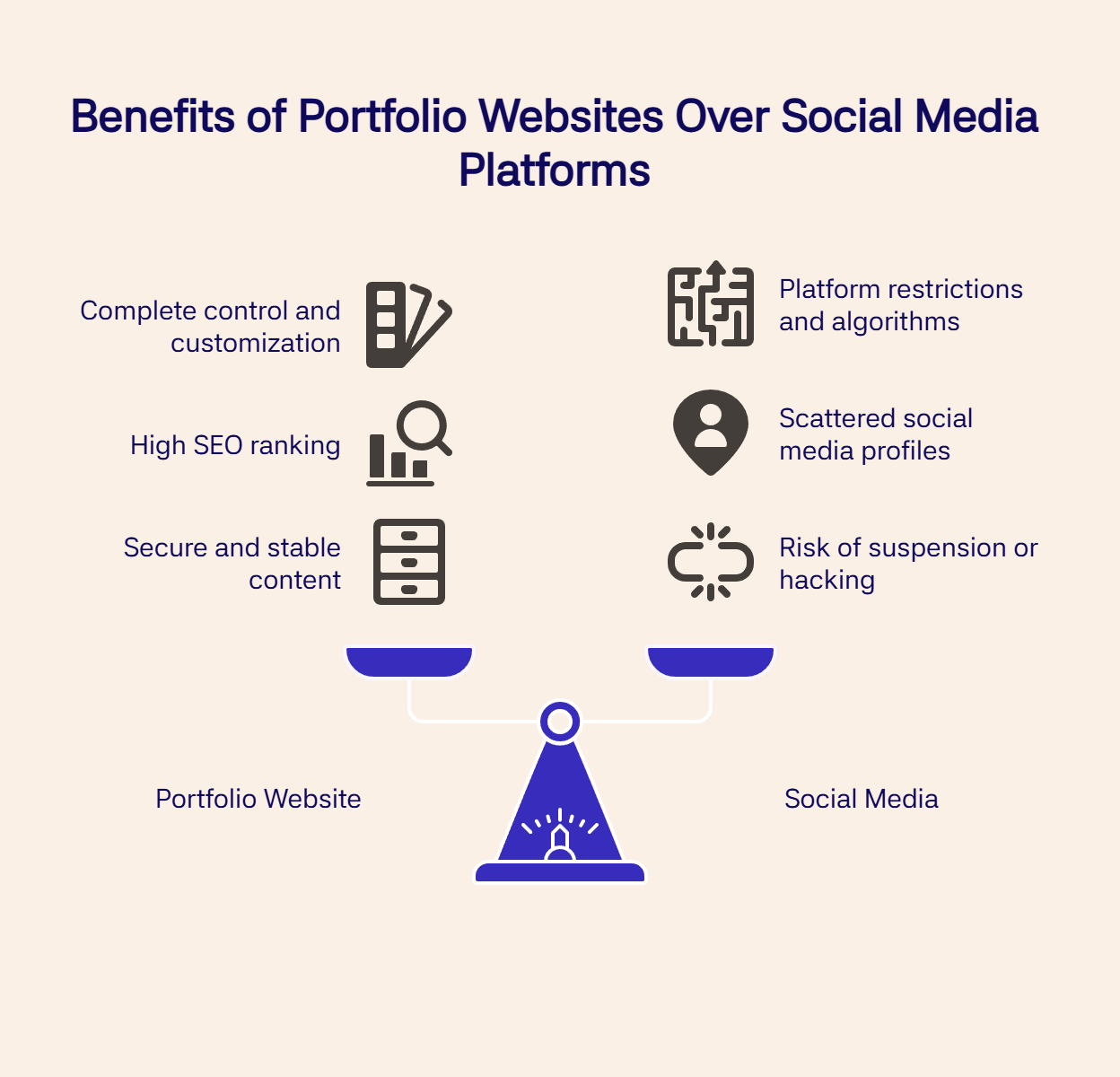A portfolio website is a personalized digital platform that displays your top projects and core professional abilities. It's your digital business card that gives potential clients and employers a complete picture of what you can do.
Your portfolio website puts you in full control of your professional image, from designers and photographers to writers and developers. Unlike social media profiles, this space belongs entirely to you.
In this blog, you're going to learn:
-
What a portfolio site is
-
What makes a great online portfolio
-
Why having a portfolio site is essential for your career
-
Inspiring portfolio examples
-
And, step-by-step guidance on creating your own portfolio website.
Let's jump in.
TL;DR:
-
Portfolio websites give complete control over your professional image, unlike social media platforms with algorithm restrictions
-
6-10 curated projects showcase expertise better than overwhelming visitors with every piece of work
-
Custom domains with SEO optimization ensure your portfolio appears first when people search your name
-
Essential elements include work samples, about section, skills, contact info, and mobile-responsive design
What Is a Portfolio Website?
A portfolio website is an organized digital platform that presents your finest professional projects in a single accessible place. It serves as your digital showcase where potential employers, clients, and collaborators can quickly understand who you are and what you create.
Portfolio websites function like an enhanced version of a traditional PDF portfolio. The key difference is that your website is always accessible, easily shareable, and completely under your control. Visitors can instantly see your work, read your story, and contact you without downloading files or waiting for email attachments.
They also adapt to fit any creative discipline. Photographers showcase visual galleries, writers display published articles, and designers present detailed project breakdowns.
The best portfolio websites reflect your unique projects, passions, and personality while maintaining professional credibility.
Now that you know what a portfolio website is, let's find out what elements will make your portfolio website stand out.
What Makes a Great Online Portfolio?
A great online portfolio combines compelling work samples with clear navigation and authentic personal branding. The most effective portfolios balance professional presentation with personality, making visitors want to learn more about you and your work.
The following five essential elements makes a great online portfolio:

-
Work samples: Display your strongest projects, case studies, and creative work that demonstrate your core abilities and unique style.
-
About section: Share your professional background, creative goals, and what motivates your work in a conversational, authentic way.
-
Skills and expertise: Highlight your technical abilities, creative talents, and specialized knowledge relevant to your target audience. For example, if you’re a graphic designer, you’ll want to explore how to create a graphic design portfolio website with layouts that best showcase visual creativity.
-
Contact information: Provide multiple easy ways for visitors to reach you through email, contact forms, or professional social media links.
-
User-friendly design: Create clean, intuitive navigation with fast loading times and mobile-responsive layouts that work on any device.
The secret portfolio website ingredient: Cohesive visual branding that ties everything together. Your color scheme, typography, and overall aesthetic should reinforce your professional identity while letting your work take center stage.
Why Is It Useful to Have a Portfolio Site?
Having your own portfolio website gives you complete ownership and control over your professional presence online. While Instagram, Behance, and Tumblr are excellent platforms for showcasing work, your own website offers unique advantages that social media simply can't match.

Your portfolio website becomes your professional home base where you set the rules, control the experience, and own your content completely.
Manage How You Appear Online
Your portfolio website puts you in complete control of your professional image. Unlike Instagram's square grids or Behance's preset layouts, your website lets you choose everything from image sizes and typography to color schemes and navigation flow.
You decide how visitors experience your work without platform restrictions or changing algorithms affecting your visibility. This creative freedom ensures your online presence perfectly reflects your unique style and professional brand.
Make It Easy for People to Discover You
Your portfolio website becomes the first result when people search your name online. Instead of forcing potential employers to hunt through multiple social platforms, you give them one clear destination that showcases everything about your work.
Smart SEO optimization helps your website rank higher in search results than scattered social media profiles. This approach eliminates confusion, especially if you have a common name, and ensures visitors find your professional work first rather than personal social accounts.
Beyond SEO basics, you can apply proven strategies on ways to increase traffic to your portfolio site to reach more clients and hiring managers.
Keep Your Work Safe and Accessible Online
Your portfolio website serves as a secure backup for all your creative work. Social media accounts can get suspended, hacked, or banned without warning, potentially wiping out years of your professional content in an instant.
Platform updates also won't disrupt your workflow or force you to learn new interfaces overnight. Your website remains stable and consistent, giving you peace of mind that your work stays accessible exactly how you designed it.
Students preparing for internships or first jobs can benefit from this guide on how to create a portfolio website for students that focuses on academic work and early career projects.
Best Portfolio Website Templates
Discover the best portfolio website templates that combine clean design, strong branding, and strategic layout. These templates highlight how effective visuals, concise messaging, and organized content can build instant trust and showcase expertise across creative and professional fields.
For even more design options, explore our curated list of the best portfolio templates that combine clean layouts, brand consistency, and strategic content organization.
AF
This portfolio template is designed for authors, but the same principles apply to any professional who wants to showcase their work online.
Use the Albert Flores template to create a professional portfolio that builds trust and showcases work clearly.
The homepage features a bold name, a clear headshot, and a credibility-boosting tagline. A clean menu with highlighted contact options ensures simple navigation. Each section balances images with text, keeping visitors engaged without overwhelming them.
Logos from Amazon, iBooks, and Audible provide instant trust signals. Books are displayed in a visual gallery with titles and call-to-action buttons.
A testimonial section adds social proof, while the blog keeps the site active and boosts SEO.
The design uses a modern layout, neutral backgrounds, and consistent gold highlights to maintain a polished, professional look.
Writers and publishers can showcase books, reviews, and events by following this complete guide on how to build an author website with templates tailored for authors.
Porto
The Porto template is designed for creative professionals like designers, UI/UX experts, and freelancers. It highlights skills, services, and past projects in a clean and engaging way. Here’s why it works well
Use this template to showcase your skills, services, and work with clarity and impact.
The homepage introduces you with a bold title, a clear description, and a direct “Contact Me” button. Clean navigation, structured layout, and multiple CTAs guide visitors from intro to contact effortlessly.
A deep navy palette with bright accents creates a modern, digital tone. Clean fonts keep the focus on content, while card-style service sections make offerings easy to scan.
The personal bio includes stats like “8 years of experience” and “100+ projects,” adding trust. The grid-style portfolio with clickable previews highlights your work visually. Testimonials and blog posts build credibility and keep your site active.
Smart spacing and logical flow enhance UX, while repeated contact prompts drive leads.
Present your creative work professionally with this client-focused, stylish template.
Carol
Carol is designed for influencers, content creators, and personal brands who want to showcase their personality, content, and social presence in one place.
Use this lively template to showcase your personal brand.
The homepage grabs attention with bold “Dreamer, Influencer, Creator” text and a dynamic hero image. A vibrant color palette and bold typography reflect an energetic, social-first identity. Clear navigation and standout CTAs make it easy for fans or brands to connect.
Social proof with large follower and view counts adds instant credibility. The site highlights fresh content through update sections, video previews, and a vibrant image gallery. A blog at the bottom expands your brand voice and boosts SEO.
The footer reinforces branding with a custom signature logo and social links.
With structured flow and strong engagement elements, this template helps creators turn content into opportunity.
Lallene
This template is designed for photographers and other visual artists who need a clean, elegant space to show off their work. It balances visual storytelling with professional presentation.
Use Lallene to present your photography with elegance and clarity.
The homepage introduces you with a warm photo, a concise tagline, and a clear “Hire Me” button. A soft color palette of whites, grays, and pink accents creates a minimalist, client-friendly tone. Serif headings and sans-serif body text deliver a premium, readable experience.
A grid-style gallery highlights projects like weddings and family sessions with large, clickable visuals.
The blog section builds authority and SEO with practical posts and guides. A detailed contact form plus direct info makes booking simple.
The footer reinforces brand style with thumbnail previews and easy navigation. Clean flow and spacious layout enhance UX, while repeated CTAs drive inquiries.
This template is ideal for photographers who want their visuals to take center stage.
Once you choose a template, compare platforms with the best portfolio website builders to ensure your site has hosting, SEO, and customization flexibility.
Best Portfolio Website Examples
If you’re looking for inspiration from real professionals, checking out live portfolio websites is just as important as browsing templates.
Explore design styles, layouts, and creative showcases from some of the best professionals worldwide. We’ve curated a dedicated list here: Best Portfolio Website Examples in 2025.
If you're a professional in marketing, you can showcase case studies, results, and campaigns by following this step-by-step guide on how to make a marketing portfolio that attracts clients and employers.
How Do I Create My Portfolio Website Using a Template?
Building your portfolio website is simple with Dorik's template collection featuring nearly 110+ designs across various categories.
Follow these steps to create your first portfolio website:
1. Navigate to Sites > CMS > Create New Site from your Dorik dashboard
2. Explore templates designed specifically for portfolios
3. Test drive templates that appeal to you, then select Create CMS Site with your preferred choice
4. Modify the template to match your vision
Consider these personalization options for your portfolio:
-
Adjust page structure by adding or removing sections based on your content requirements
-
Insert your brand logo for a distinctive, professional appearance
-
Revise headings, captions, and copy to match your unique voice and style
-
Generate compelling visuals using AI-powered image creation tools
-
Use AI writing assistance for headlines, content blocks, or complete page makeovers
What makes this process exceptional is Dorik AI's ability to handle these modifications in minutes rather than hours. This efficiency will preserve valuable time for focusing on your actual portfolio content.
If your site is centered on personal branding, choose from the best website builders for personal portfolio to highlight skills and career milestones.
FAQs
Do I need a portfolio website if I already use LinkedIn or Behance?
Yes. A portfolio website gives you complete ownership of your professional presence online. Unlike LinkedIn or Behance, you control the design, layout, and content, making it easier to reflect your unique style. It also becomes a central hub where clients or employers can explore your work without distractions.
How many projects should I include in my portfolio website?
Include 6–10 of your strongest projects that best showcase your skills and style. A curated selection makes a stronger impression than overwhelming visitors with every project. Each featured project should highlight your role, process, and results so potential clients or employers quickly understand your expertise.
Should I use a free website builder or invest in a custom domain?
Invest in a custom domain if you want to appear professional and trustworthy. Free website builders often include platform branding in the URL, which can reduce credibility. A custom domain with your name or brand reinforces your identity, builds trust, and makes your site easier to share.
How do I make sure my portfolio website shows up on Google?
Optimize your site with basic SEO practices. Use descriptive titles, meta descriptions, and alt text for images. Include your name and profession in key headings. Regularly update your site with fresh content like blog posts. Submitting your site to Google Search Console also helps ensure your portfolio is indexed and discoverable.
Can I build a portfolio website without knowing how to code?
Yes. Modern website builders like Dorik, Wix, and Squarespace let you create professional portfolio websites without coding. You can choose a template, customize colors, text, and layout, and launch your site in minutes. AI-powered tools also make editing content and images even easier for beginners.
What’s the difference between a portfolio website and a personal blog?
A portfolio website showcases your professional work, skills, and achievements to attract clients or employers. A personal blog shares thoughts, stories, or industry insights. Use a portfolio when you want to present your projects and expertise, and add a blog if you want to expand your voice, boost SEO, or share knowledge.
How often should I update my portfolio website?
Update your portfolio website every 3–6 months or whenever you complete a major project. Regular updates keep your content fresh, signal activity to search engines, and show potential clients that you’re active in your field. Outdated portfolios may create the impression that you’re not currently working.
What are common mistakes to avoid when creating a portfolio website?
Avoid cluttered layouts, slow-loading pages, and unclear navigation. Don’t overload your site with too many projects or irrelevant details. Weak or missing CTAs can cause you to lose leads, and ignoring mobile optimization limits your audience. A clean design, fast performance, and strong calls-to-action make your portfolio effective.
Wrap Up
Once your portfolio website is live, you're ready to share it everywhere! Include the link in your email signature, CV, cover letters, social media profiles, and PDF portfolios to maximize visibility.
Remember that your portfolio website is a living document that grows with your career. Regular updates keep your site fresh and relevant - swap old projects for new ones, adjust your design, or completely refresh your visual style as your skills evolve.
Your portfolio website should change as you do. Keep it current, keep it polished, and keep sharing it with the world.





